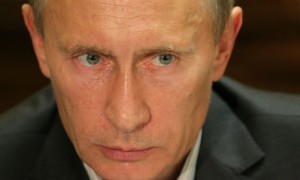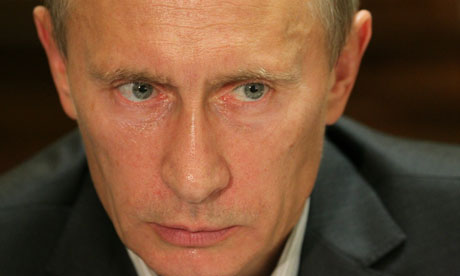by Larry Franklin
 Vladimir Putin has succeeded in portraying himself as a leader of a resurgent Russia. The three-term President of the Russian Federation has proven to be a skilled manipulator of the media and masterful political tactician. He has burnished his image of a man of action who has catapulted Russia back into the front rank of nations. He has convinced most Russians that he has outwitted the West which, he claims, humiliated weak Russian governments since the demise of the Soviet Union in 1991. He is perceived by many Russian nationalists as having restored the glory and dignity of the Russia’s military tradition after its catastrophic defeat in Afghanistan(1) and its poor performance in the First Chechen War (2). Successive victories in the Second Chechen War (3), the border conflict with Georgia (4), and the nearly bloodless seizure of the Crimean Ukraine (5) under Putin is perhaps the greatest single factor which has sustained his popularity. He is viewed as a champion of the Great Russian ethnic group by his support of ethnic-Russians in the Eastern Ukraine, the Baltic States and among Russian-speakers in Central Asia. His administration has helped establish and expand the Shanghai Cooperation Organization (SCO) (6) while pushing his agenda to reconstitute Tsarist and Communist Russian political and military relationships with the former Soviet Republics of Central Asia. There remain significant Russian-speaking populations in these new states which have strong cultural ties to Mother Russia.
Vladimir Putin has succeeded in portraying himself as a leader of a resurgent Russia. The three-term President of the Russian Federation has proven to be a skilled manipulator of the media and masterful political tactician. He has burnished his image of a man of action who has catapulted Russia back into the front rank of nations. He has convinced most Russians that he has outwitted the West which, he claims, humiliated weak Russian governments since the demise of the Soviet Union in 1991. He is perceived by many Russian nationalists as having restored the glory and dignity of the Russia’s military tradition after its catastrophic defeat in Afghanistan(1) and its poor performance in the First Chechen War (2). Successive victories in the Second Chechen War (3), the border conflict with Georgia (4), and the nearly bloodless seizure of the Crimean Ukraine (5) under Putin is perhaps the greatest single factor which has sustained his popularity. He is viewed as a champion of the Great Russian ethnic group by his support of ethnic-Russians in the Eastern Ukraine, the Baltic States and among Russian-speakers in Central Asia. His administration has helped establish and expand the Shanghai Cooperation Organization (SCO) (6) while pushing his agenda to reconstitute Tsarist and Communist Russian political and military relationships with the former Soviet Republics of Central Asia. There remain significant Russian-speaking populations in these new states which have strong cultural ties to Mother Russia.
Domestically, the Putin-Medvedev era presidencies (7) have supported incentive programs to encourage Russian households to have larger families. Recently, the Duma (8) has sponsored legislation placing restrictions on the use of non-Russian minority languages. Moreover, the Kremlin has allocated financial resources for the settlement of ethnic Russians from eastern Ukraine into Muslim republics of the North Caucasus. Culturally, Putin has forged friendly relations with Russian nationalists within the hierarchy of the Russian Orthodox Church. Additionally, Putin’s administration has maintained unofficial contacts between Russian hard-right youth gangs and government intelligence operatives. These thugs are sometimes encouraged to focus their hostile attention on pro-western liberal intellectuals and Turkic internal emigrants from Central Asia and the Caucasus who have come Russia’s European cities to find employment.
However, despite these foreign and domestic programs to stimulate the growth of the ethnic Russian population and the maintenance of its political dominance, demographic realities will soon dissipate this chimera revealing the nightmare that is upon Russia. For instance, Muslims already account for more than 15% of the Russian Federation’s population.(9) Excepting Istanbul, Moscow is the largest Muslim city in Europe. Its more than a million non-Russian speaking minorities have migrated largely from the Muslim territories of Transcaucasia, the Caucasus, and Central Asia. The demographic trends do not favor an ethnic Russian majority in Russia beyond another generation. Eurasian expert Paul Gobel cites a 40% to 50% increase in the Muslim population of Russia since 1989. (10) The birth ratio for Russian women in Moscow is 1.1 but for their Muslim compatriots it is 2.3. (11) Birth rates for Russia’s internal Muslim Republics are equally unfavorable for ethnic Russians vice their Turkic fellow citizens. The high rate of abortion among ethnic Russian women further aggravates the situation. These demographic trends when combined with negative social patterns will only accelerate the decline in the Federation’s Russian population. For instance, the life expectancy of the Russian male is ten years shorter than the lifespan of his Turkic counterpart. (12) This macabre statistic is a microcosm of a depressing larger picture. The population of Russia shrinks every year by at least half a million. (13) This statistic, in part, reflects the outflow of Russia’s educated young to the EU and the US, underscoring a major brain drain from the Federation.
Moreover, there are discouraging prospects for the domestic tranquility and territorial integrity of the Russian Federation. Russia’s emerging Muslim majority will likely be extremist and Sunni Salafist. (14) Russia’s recent encounters with the Muslim world have been uniformly negative. The Soviet Union was perceived by most Muslims as the atheistic antithesis of an Islamic polity. This ideological hostility was drenched in blood by the international brigades of Mujahedin volunteers who fought against the Soviet occupation of Afghanistan. This anti-Soviet global Jihad was followed by a similar pattern of worldwide recruitment of Muslim volunteers against Moscow’s military misadventures in Chechnya and the Kremlin’s aggressive counterterrorist policies throughout the Islamic Republics of the North Caucasus.
Another dimension of the increased alienation of the Russian Federation’s Muslim peoples from Moscow is the proselytizing energy of Wahhabi sect donors from the Arabian Peninsula. Saudi money was made available to build new mosques, to stock affiliated libraries with radical Islamic tracts, to finance the hiring of Salafist Imams, and to grant scholarships to young Muslim males to study theology on the Arabian Peninsula. These developments have resulted in the near total eclipse of a political Sufi quietist Islam in the North Caucasus. The historical profile of Islam throughout these mountainous republics which has passively and often militarily resisted Russian occupation during the last two centuries has given way to a militant hybrid which is only superficially traditionalist. It will not be long before Putin is presented with the nightmare of not one but many emirates inside the great belly of Mother Russia.
. . . . . . . . . . . . . . . .
Larry Franklin is a senior fellow at Frontiers of Freedom.
. . . . . . . . . . . . . . . .
Footnotes:
1 Soviet troops invaded Afghanistan on 27 December 1980. Moscow withdrew its forces from the country in 1988 after having suffered at least 20,000 dead.
2 Following the implosion of the Soviet Empire in 1991, Chechnya declared its independence as the Republic of Ichkeria. Russian troops invaded the North Caucasian Republic in 1994 but were forced ignominiously to withdraw in 1996.
3 The Second Chechen War was triggered by an incursion into Dagestan, a neighboring North Caucasus republic of the Russian Federation on 26 August 1999. The invasion consisted of a radical Islamic coalition of foreign and regional Muslims. Russian troops entered Chechnya on 1 October 1999. The Russian military and its pro-Moscow indigenous allies succeed in militarily defeating the Jihadists but did not fully suppress the rebels until, May, 2005. Pockets of organized military resistance continued occasional operations until 2009.
4 Russian troops quickly dispatched Georgia’s Army in five days in August 2008 while the Kremlin assured autonomy of two pro-Moscow regions of the Georgian nation-state, South Ossetia and Abkhazia. This clash between Moscow and Tbilisi was allegedly an outgrowth of two wars in the early 1990s between Georgia and South Ossetia. In the 2008 war between Russia and Georgia, Moscow recognized the independence of these political entities. However, South Ossetia and Abkhazia have been drawn ever-closer to possible eventual formal integration into the Russian Federation..
5 Soviet special operation forces seized control of Crimea (ratified on 16 March 2014) after paltry resistance by Ukraine’s resident military. The seizure guaranteed the Kremlin’s control of naval port facilities needed for the stationing of its Black Sea fleet.
6 The SCO was established in 2001 after having evolved from the Shanghai Five founded in 1996. Its five original members were China, Russia, Kazakhstan, Tajikistan and Kyrgyzstan. Uzbekistan became its sixth member nation. The SCO is a political-military-commercial multinational regional effort to counter the influence of Euro-Atlantic influence in Central Asia, led by the United States. The SCO could eventually expand as there are several observer and guest category nations.
7 Putin’s two presidential terms of office were (2000-2008) This was followed by an interregnum where Dmitri Medvedev and Putin switched offices to satisfy the requirements of the Russian Constitution which bared three consecutive Presidential term. During the Medvedev administration (2008-2012), Putin became Prime Minister until he was again elected Russia’s President in 2012.
8 Duma is the term for Russia’s legislative branch of government.
9 Washington Times Article 26 October 2013.
10 Paul Gobel Lecture at the Institute of World Politics, Washington D.C.
11 Washington Times, 26 October 2013.
12 Ibid.
13 See the Philadelphia-based Middle East Forum’s (MEF) internet blog article updates written by MEF President Daniel Pipes blog “Predicting a Muslim Majority Russia.” (6 August 2005 through 7 June 2014).
14 Salafist is an Islamic theological term which denotes the conservative traditionalist orthodox views of Muslims typical of residents of Saudi Arabia, the Emirates, and Pakistan.
